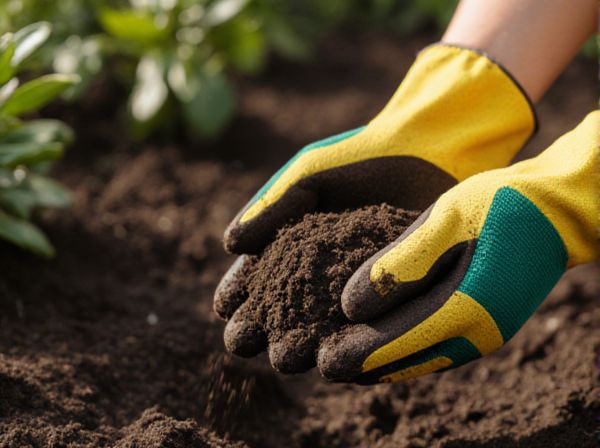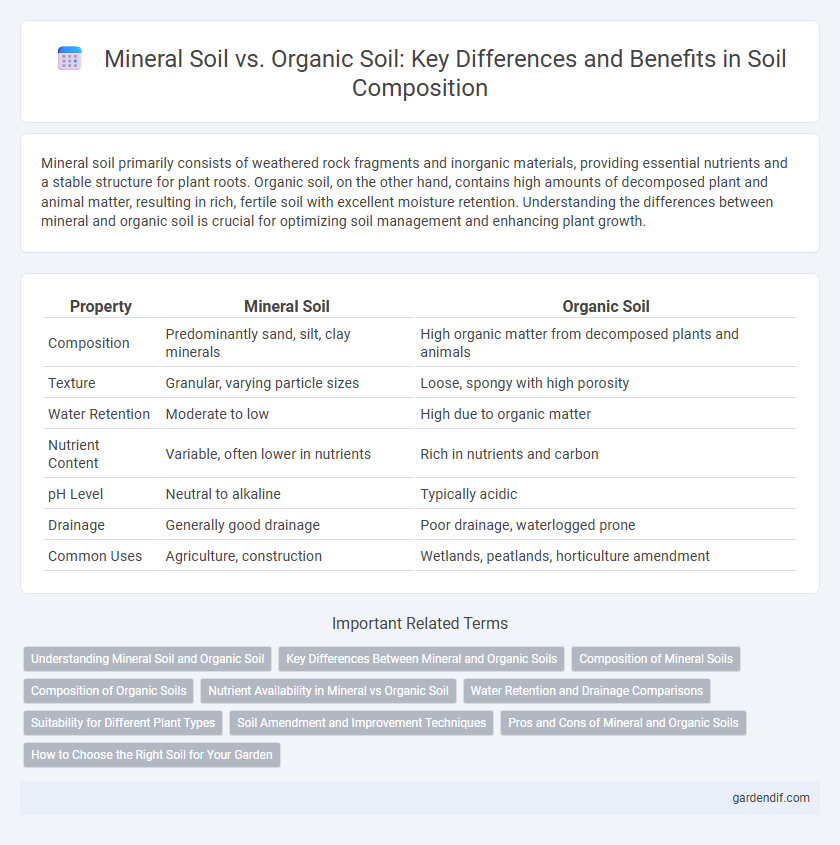
Mineral soil vs Organic soil Illustration
Mineral soil primarily consists of weathered rock fragments and inorganic materials, providing essential nutrients and a stable structure for plant roots. Organic soil, on the other hand, contains high amounts of decomposed plant and animal matter, resulting in rich, fertile soil with excellent moisture retention. Understanding the differences between mineral and organic soil is crucial for optimizing soil management and enhancing plant growth.
Table of Comparison
| Property | Mineral Soil | Organic Soil |
|---|---|---|
| Composition | Predominantly sand, silt, clay minerals | High organic matter from decomposed plants and animals |
| Texture | Granular, varying particle sizes | Loose, spongy with high porosity |
| Water Retention | Moderate to low | High due to organic matter |
| Nutrient Content | Variable, often lower in nutrients | Rich in nutrients and carbon |
| pH Level | Neutral to alkaline | Typically acidic |
| Drainage | Generally good drainage | Poor drainage, waterlogged prone |
| Common Uses | Agriculture, construction | Wetlands, peatlands, horticulture amendment |
Understanding Mineral Soil and Organic Soil
Mineral soil is primarily composed of inorganic particles such as sand, silt, and clay, originating from the weathering of rocks, and it typically contains low levels of organic matter. Organic soil, often referred to as peat or muck, consists mainly of decomposed plant material and high concentrations of organic carbon, which enhances water retention and nutrient availability. Understanding the distinct properties of mineral and organic soils is essential for effective soil management, agricultural productivity, and ecosystem sustainability.
Key Differences Between Mineral and Organic Soils
Mineral soils consist primarily of inorganic particles such as sand, silt, and clay, with low organic matter content and high mineral nutrient availability, making them ideal for most agricultural activities. Organic soils, also known as histosols, contain more than 20% organic matter derived from decomposed plant and animal material, resulting in higher water retention and slower nutrient cycling. Key differences include texture, nutrient content, drainage capacity, and biological activity, with mineral soils generally offering better aeration and organic soils providing enhanced carbon storage and moisture regulation.
Composition of Mineral Soils
Mineral soils primarily consist of weathered rock particles such as sand, silt, and clay, with a relatively low organic matter content, typically less than 20%. These soils contain essential minerals like quartz, feldspar, and mica, which influence nutrient availability and soil texture. The high mineral content provides structure and drainage properties crucial for plant root development and soil aeration.
Composition of Organic Soils
Organic soils primarily consist of decomposed plant and animal matter, rich in carbon-based compounds and humus, which enhance soil fertility and moisture retention. Unlike mineral soils that are predominantly composed of inorganic particles such as sand, silt, and clay, organic soils contain high levels of organic carbon, typically exceeding 20%. This elevated organic content influences soil structure, nutrient availability, and microbial activity, making organic soils essential for ecosystems like wetlands and peatlands.
Nutrient Availability in Mineral vs Organic Soil
Mineral soil contains a higher concentration of essential minerals such as calcium, magnesium, and potassium, making nutrient availability more immediately accessible for plant uptake. Organic soil, rich in decomposed plant and animal matter, enhances nutrient retention and slow-release through microbial activity, improving long-term fertility. The balance between mineral composition and organic content determines overall soil nutrient dynamics and plant growth potential.
Water Retention and Drainage Comparisons
Mineral soil consists primarily of sand, silt, and clay particles, providing moderate water retention with efficient drainage due to larger pore spaces. Organic soil, rich in decomposed plant material and humus, exhibits high water retention capacity but tends to have slower drainage rates because of its dense, spongy structure. The balance of water retention and drainage in these soils directly impacts plant root health and nutrient availability.
Suitability for Different Plant Types
Mineral soil, rich in inorganic particles like sand, silt, and clay, provides excellent drainage and is ideal for plants requiring well-aerated root zones such as succulents and vegetables. Organic soil contains high amounts of decomposed plant material, offering superior nutrient retention and moisture-holding capacity, making it suitable for moisture-loving plants like ferns and acid-loving species. Selecting soil type based on plant water and nutrient demands enhances growth efficiency and overall plant health.
Soil Amendment and Improvement Techniques
Mineral soil, composed primarily of sand, silt, and clay, benefits from soil amendments such as gypsum, lime, and organic compost to enhance nutrient availability, pH balance, and structure. Organic soil, rich in decomposed plant material and humus, often requires careful management of carbon-to-nitrogen ratios and the incorporation of biochar or mulch to improve aeration, moisture retention, and microbial activity. Both soil types respond positively to techniques like cover cropping, rotational tillage, and microbial inoculants for sustained fertility and structural integrity.
Pros and Cons of Mineral and Organic Soils
Mineral soils, rich in sand, silt, and clay particles, offer excellent drainage and stability but often require added organic matter for nutrient retention and fertility. Organic soils, abundant in decomposed plant material, provide high nutrient content and water retention yet can suffer from poor structure and drainage challenges. Understanding these differences helps in choosing the right soil type for agriculture and landscaping based on nutrient needs and moisture management.
How to Choose the Right Soil for Your Garden
Mineral soil, rich in sand, silt, and clay, provides excellent drainage and stability, making it ideal for vegetables and flowers that require well-aerated roots. Organic soil, abundant in decomposed plant material and humus, retains moisture and nutrients, supporting moisture-loving plants such as ferns and hostas. To choose the right soil for your garden, assess your plants' moisture and nutrient needs along with your garden's drainage conditions to ensure optimal growth.
Mineral soil vs Organic soil Infographic

 gardendif.com
gardendif.com